Related Research Articles
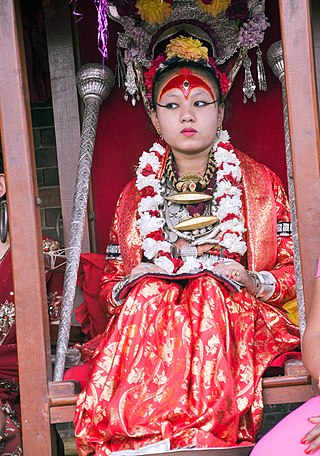
Kumari, or Kumari Devi, or the Living Goddess, is the tradition of worshipping a chosen virgin as manifestations of the divine female energy or Shakti in Dharmic religious traditions. It is believed that the girl is possessed by the goddess Taleju or Durga. The word Kumari is derived from Sanskrit meaning princess. The procession is akin to Indra or Sakra, taking Indrani to his celestial abode as his bride. The festival is celebrated during Kumari Jantra, which follows the Indra Jatri religious ceremony.

Newar or Nepami, are the historical inhabitants of the Kathmandu Valley and its surrounding areas in Nepal and the creators of its historic heritage and civilisation. Newars form a linguistic and cultural community of primarily Indo-Aryan and Tibeto-Burman ethnicities following Hinduism and Buddhism with Nepal Bhasa as their common language. Newars have developed a division of labour and a sophisticated urban civilisation not seen elsewhere in the Himalayan foothills. Newars have continued their age-old traditions and practices and pride themselves as the true custodians of the religion, culture and civilisation of Nepal. Newars are known for their contributions to culture, art and literature, trade, agriculture and cuisine. Today, they consistently rank as the most economically and socially advanced community in Nepal, according to the annual Human Development Index published by UNDP. Nepal's 2011 census ranks them as the nation's sixth-largest ethnicity/community, with 1,321,933 Newars throughout the country.
Ranjitkar is one of the castes of Newar. The Newari caste system is divided according to profession. The Ranjitkar caste is concerned with the dyeing of clothes as well as other color related activities. The word "Ranjitkar" comes from Sanskrit origins crudely meaning "people concerned with colors" whereas the word "Chhipaa" is a Nepal Bhasa compound word which can be roughly translated as "color and allow to dry".
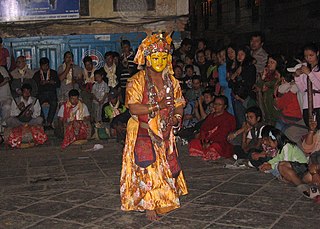
Newar Dance consists of the whole array of dances that are traditionally performed by Newars.
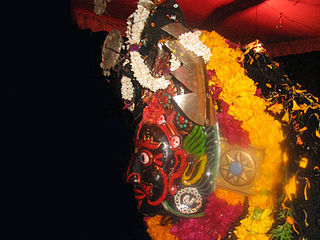
Bhairab Pyankhan. "Bhairava's Dance" is an ancient masked dance performed by Newar community in the Pokhara Valley of Nepal as part of the Bhairab Jatra festival and named after Bhairab Bhairava, an aspect of Shiva.

Gai Jatra, also known by its endonym Sa Paru, is a Nepalese festival celebrated mainly in the Kathmandu valley by the Newar people. The festival is celebrated in honour of their immediate relatives who have died during the previous year. Various groups of children dressed up as cows and in other comedic drags are organized throughout various cities.

Madhyapur Thimi, also known as Thimi, is a municipality in Bhaktapur District in the Bagmati Zone of central Nepal. Thimi lies between Kathmandu, Lalitpur and Bhaktapur in the Kathmandu Valley. It is one of the ancient cultural and historical places along the trade route from Bhaktapur to Kathmandu. The city is situated on elevated land and occupies an area of 11.47 square kilometres (4.43 sq mi), divided into nine administrative wards.
Bungamati, is a settlement in Lalitpur Metropolitan Region, Ward No. 22 in Lalitpur District, Nepal. Bungamati is a Newar town on a spur of land overlooking the Bagmati River

Khokana is a former Village Development Committee (VDC) which has been merged with the neighbouring VDC's of Bungamati, Chhampi, Dukuchhap, Sainbu and other 38 VDC's to form the Metropolitan City of Lalitpur in Lalitpur District in the Bagmati Zone of central Nepal. At the time of the 1991 Nepal census, Khokana had a population of 4258 living in 699 individual households. According to 2011 Nepal census, Khokana had a population of 4927 living in 1056 individual households.
Thecho is located about 6 km (3.7 mi) south of the main Lalitpur town in Lalitpur district, Godawari Municipality. According to 2011 Nepal census, Thecho has a population of 10,086 living in 2,352 individual households. The offshoot road near the Satdobato segment of the Ring Road leads to Thecho. This roads ultimately leads to Lele and is referred to as Satdobato-Tika Bhairab Road. This road is also called a "Laxmi Prasad Highway" which leads to Hetauda. Thecho has its own unique culture and festivals which include the balkumari jatra,bramayani jatra,nawadurga jatra and sindur jatra locally known as Sinha jatra
Sunaguthi is a small town located about 4 km (2.5 mi) south of the main Lalitpur city in Lalitpur District. According to 2011 Nepal census, Sunaguthi has a population of 10,092 living in 2397 individual households. Most of the people living in Sunaguthi are Newar. The offshoot road near the Satdobato segment of the Ring Road leads to Sunaguthi. This road ultimately leads to Lele and is referred to as Laxmi Prasad Devkota Marga .Thecho is situated on the southern part of Sunaguthi, Bungamati and Bhaisipati on west, Dhapakhel on east and Khumaltar and Nakhipot on North.

Indra Jātrā, also known as Yenyā, is the biggest religious street festival in Kathmandu, Nepal. The celebrations consist of two events, Indra Jātrā and Kumāri Jātrā. Indra Jātrā is marked by masked dances of deities and demons, displays of sacred images and tableaus in honor of the deity Indra, the king of heaven. Kumāri Jātrā is the chariot procession of the living goddess Kumari.
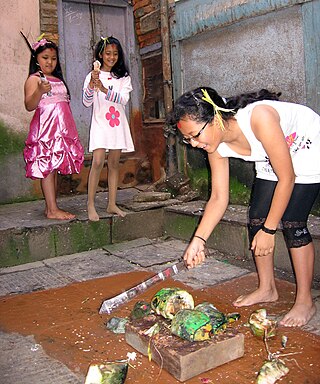
Mohani or Mohni is one of the most important festivals among the Newars which involves a packed itinerary of religious services, pilgrimages, family gatherings and outdoor celebrations lasting several days. Special dinners known as Nakhtya, to which all the relatives are invited, continue for weeks later. Mohani is the equivalent of Nepal's biggest festival Dasain, and there are similarities and differences between the two.
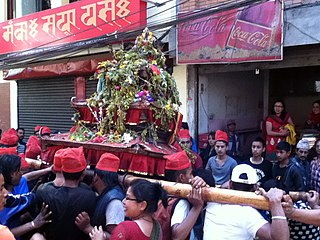
Pāhān Charhe also known as Pāsā Charhe is one of the greatest religious festivals of the year in Nepal Mandala. It is celebrated with particular fervor in Kathmandu, and consists of a conglomeration of activities including parades, masked dances, horse racing and religious worship held over three days in different places.

Siddhikali Temple is a Hindu temple located in Thimi, Nepal. The two storeys roofed temple is dedicated to Lord Kali, Shiva and Ganesh. It is also believed that this Shaktipeeth is formed due to the falling of right eye of the corpse of Sati. This place is located in Inayekwo, in the north west of Thimi. The temple is also known as Inayekwo Dyo in Nepal Bhasa language. And Siddhikali Temple is also known as Chamunda, one of the goddess of Astamatrika. The majestically impressive Siddhikali temple has numbers of Pataa streaming down the front. There's a Satah (rest-house) opposite to temple and multiple Falcha (Inns) and several smaller shrines to the rear and nearby and several stone taps around the place. The artwork around the Siddhikali temple is fantastic and worth a close inspection.

Dance is a performing art form consisting of purposefully selected sequences of human movement. Dance (Nepali: नृत्य/ नाच) in Nepal comprises numerous styles of dances, including folk, ethnic, classical to modern dances. Lakhey is the dance of a demon in the carnival of God. Durbar Square, a historic plaza in Kathmandu, Nepal, facing ancient palaces and adorned by Hindu temples, is always full of eager crowds on the last day of Indra Jatra, the festival celebrating Indra, the Hindu king of heaven. In this divine stage, Lakhe the demon dances among gods and deities relentlessly and carelessly.
Balkumari Temple of Bhaktapur District is one of four Kumari temples in Kathmandu Valley. The temple was built in the 17th century. In 2015, the original idol of Digu Bhairav from the 17th century was stolen from the temple.
Indrayani Jatra is an annual celebration done at Kathmandu, Nepal. The festival is held for eight days every year, starting on Marga Krishna Ekadashi. The festival is celebrated by both Buddhist and Hindu communities together. The origin of the Jatra is unknown, but is believed to be started by the Licchavi.
References
- 1 2 3 "The great lengths Thecho residents go to make 12-year Navadurga Jatra grand" . Retrieved 2023-07-17.
- ↑ "Nawa Durga Bhawani jatra begins at Thecho". 2023-07-17. Retrieved 2023-07-17.
- ↑ "Bhaktapur's Navadurga Naach: How a life cycle ends to be reborn after 2 months - OnlineKhabar English News". 2021-07-06. Retrieved 2023-07-17.